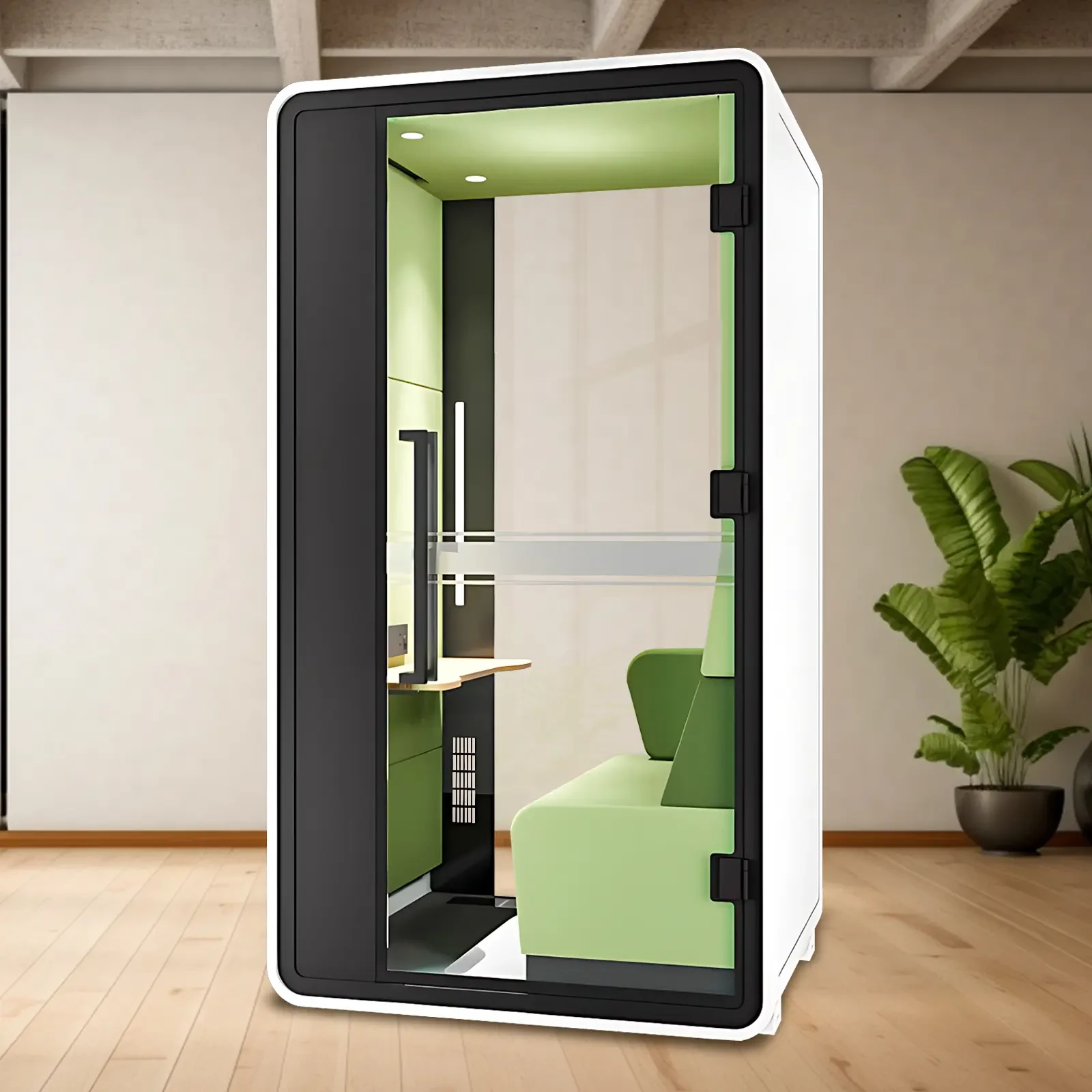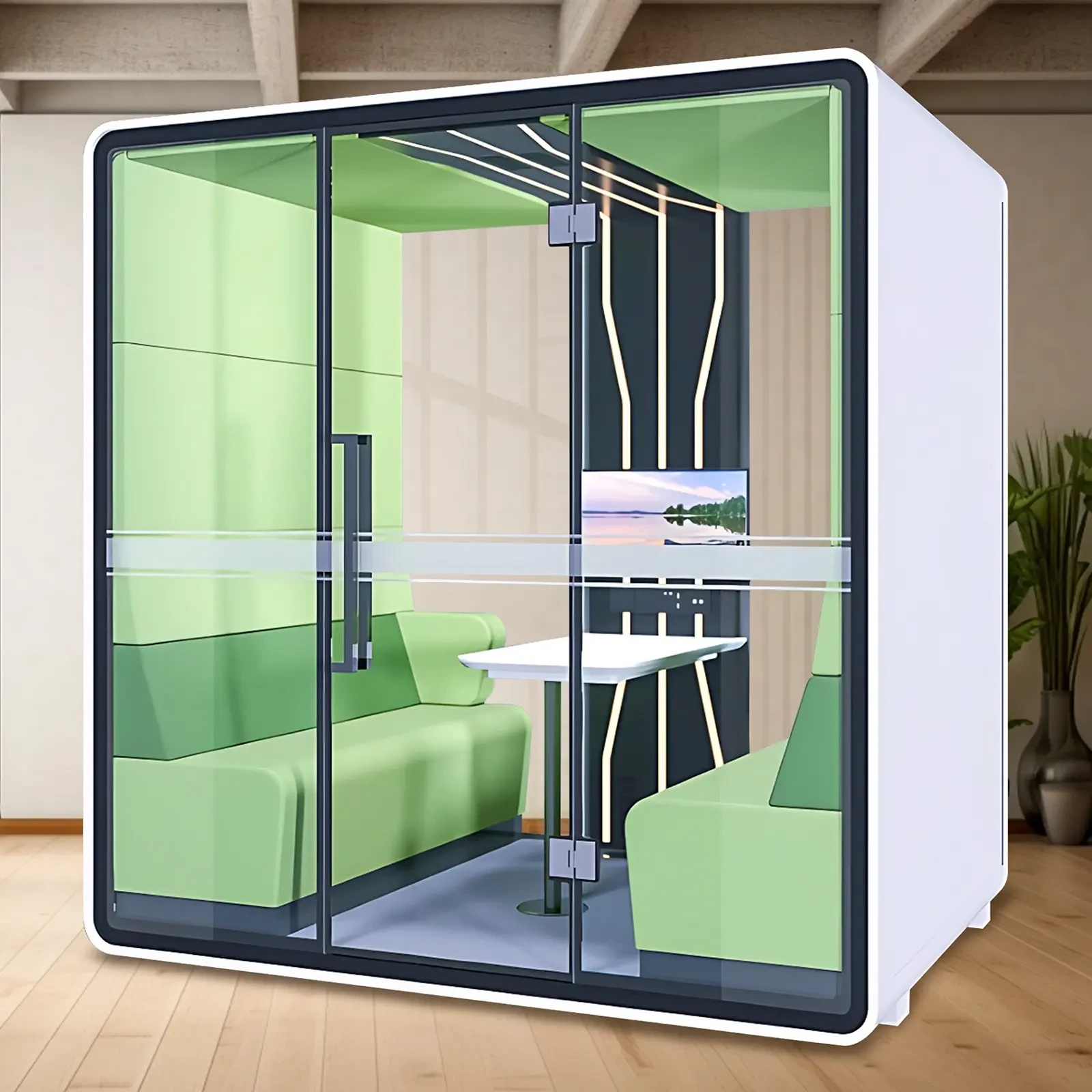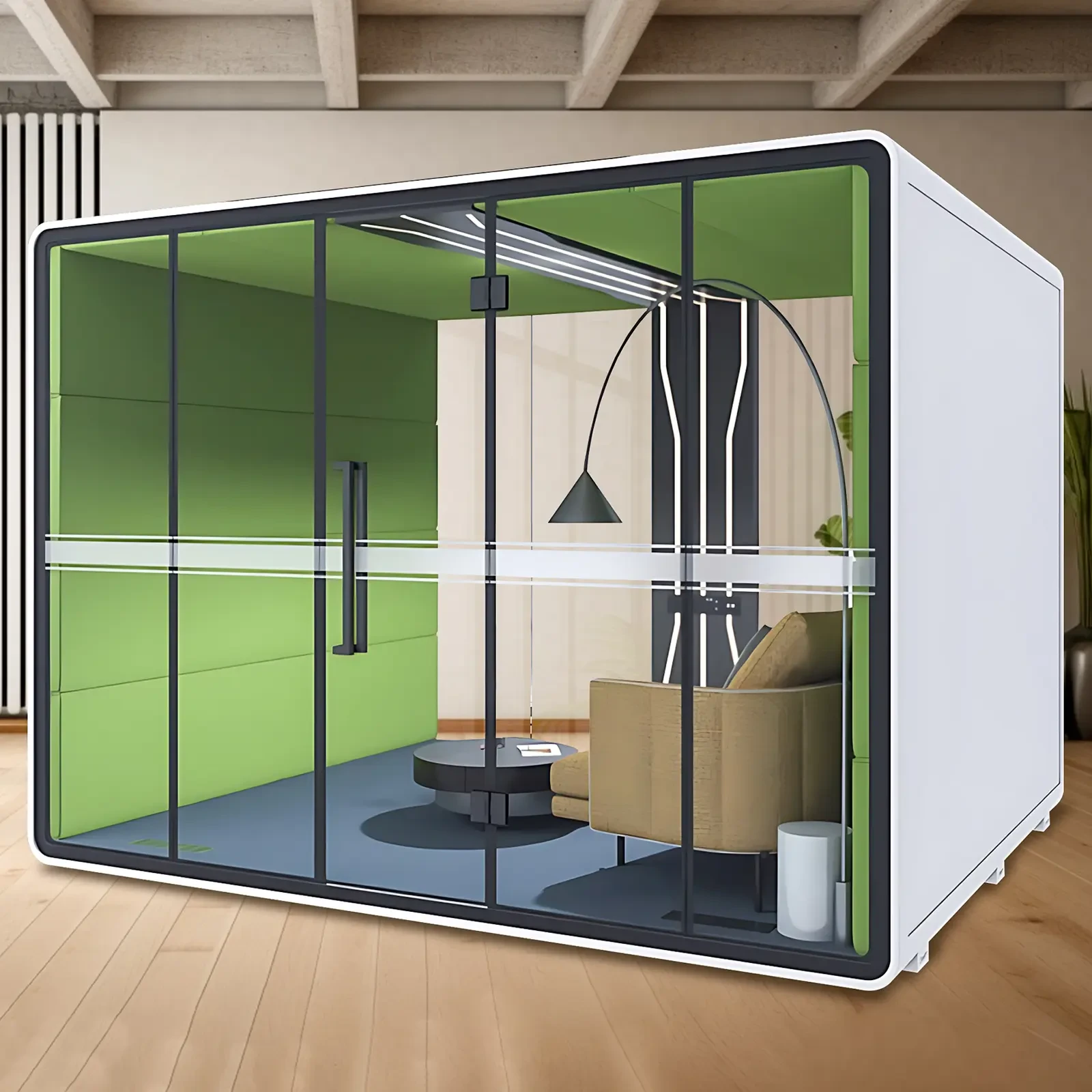Soundproof booths primarily serve the following purposes in an office environment:
I. Improved Work Efficiency and Focus
* Reduced Noise Interference
Soundproof booths, through high-density soundproofing materials and design, effectively isolate common office noises (such as conversations, telephone rings, and keyboard clicks), helping employees concentrate on complex tasks.
* Promoted Deep Working State
In a quiet environment, employees can more easily enter a distraction-free deep working mode, improving efficiency in tasks such as programming, design, and data analysis.
* Reduced Distractions
The independent space of a soundproof booth reduces visual and auditory interference, preventing work interruptions caused by colleagues' activities or sudden noise.
II. Protected Employee Physical and Mental Health
* Prevented Hearing Damage
Prolonged exposure to noisy environments can damage hearing; soundproof booths protect employees' hearing health by reducing noise exposure risks.
* Relieved Psychological Stress
Reducing noise-induced anxiety and irritability creates a calm working atmosphere, contributing to mental health.
III. Optimize Corporate Image and Collaboration Quality
Demonstrating Professionalism and Humanistic Care
Equipping soundproof booths reflects the company's emphasis on the employee's working environment, enhancing customer or partner recognition of the company's professionalism.
Enhancing Communication Privacy
Providing a secure space for meetings or sensitive discussions, preventing information leaks while ensuring clarity of communication.
IV. Creating a Comfortable Working Environment
Physical Comfort
The booths are typically equipped with ergonomic chairs, adjustable lighting, and ventilation systems, supporting long hours of efficient work.
Balancing Work and Rest
Providing employees with a "haven" to temporarily escape the open office area, helping them recharge and improve their work performance.
V. Flexible Adaptability to Diverse Scenarios
Adapting to Modern Office Trends
Meeting the needs of remote and hybrid work models for flexible space, improving space utilization.
Soundproof Booth Material Analysis: Which Material is the Best for Sound Insulation?
The choice of sound insulation materials is crucial for different application scenarios. Here is an analysis of several common sound insulation materials and their sound insulation effects:
Mass Loaded Vinyl (MLV):
Features: This material is heavy and dense, commonly used for sound insulation of walls, ceilings, and floors.
Sound Insulation Effect: Excellent. It effectively blocks airborne sound, especially low-to-mid-frequency sounds.
Gypsum Board:
Features: Gypsum board is relatively inexpensive, easy to install, and can increase wall thickness, thus improving sound insulation.
Sound Insulation Effect: Good. Sound insulation performance can be effectively improved by using multiple layers of gypsum board with sound insulation materials interspersed within.
Mineral Wool/Fiberglass:
Features: This material has good sound absorption properties and is often used as filling material inside walls and ceilings.
Sound Insulation Effect: Good to Excellent. It absorbs and attenuates sound waves, especially mid-to-high-frequency sounds, but needs to be used in combination with other sound insulation materials to achieve the best effect.
Acoustic Foam:
Features: Lightweight and easy to handle, commonly used for acoustic treatment inside rooms, rather than structural sound insulation.
Sound Insulation: Moderate. Primarily used to absorb echoes and reflected sound, not for complete soundproofing.
Soundproof Windows:
Features: Uses multi-layered glass and an airtight soundproof layer, effectively blocking external noise.
Sound Insulation: Excellent. Particularly suitable for rooms requiring complete noise insulation.
Composite Soundproof Panels:
Features: Composed of various soundproofing materials, offering good overall sound insulation performance.
Sound Insulation: Excellent. Commonly used in applications requiring high sound insulation, such as recording studios and home theaters.
Soundproof Doors:
Features: Typically designed with multiple layers of materials, providing good sealing performance.
Sound Insulation: Good to Excellent. Especially effective when using specialized soundproofing strips between the door frame and door leaf.
In summary, the most effective soundproofing materials are often high-density, high-quality materials, such as mass damping materials and composite sound insulation panels. However, optimal sound insulation usually requires the combined application of multiple materials. For example, filling the walls with mineral wool or glass wool, and then covering them with multiple layers of gypsum board and mass damping materials, can significantly improve overall sound insulation performance. The specific material selection should be determined based on actual needs and application scenarios.
The Power of Quiet Spaces: How Soundproof Enclosures Enhance Focus and Creativity?
In today's noisy work environments, focus and creativity are often disrupted by various factors. Soundproof enclosures, as a solution providing quiet spaces, are increasingly recognized for their important role in enhancing focus and creativity. This article will explore how soundproof enclosures can create a quiet working environment, providing ideal conditions for people to improve their focus and creativity.
1. Eliminating External Noise Interference
Soundproof enclosures utilize highly efficient sound insulation materials to effectively block external noise interference, creating a quiet working environment for users. This quiet space helps people concentrate more easily, avoiding distractions from external noise, thereby improving focus.
2. Creating a Private Workspace
Soundproof pods provide users with a private workspace, allowing them to focus on work without distractions. Compared to open-plan offices, soundproof pods better meet individual work needs, creating a more comfortable and quiet working atmosphere, thereby improving work efficiency and creativity.
3. Providing a Positive Work Experience
Soundproof pods are typically equipped with comfortable seating, spacious workbenches, and good ventilation, providing users with a comfortable and human-centered work environment. This positive work experience can stimulate creativity, helping people better realize their potential, thereby improving work efficiency and creativity.
4. Facilitating Communication and Collaboration
While soundproof pods provide a private workspace, this does not mean that communication and collaboration with others are hindered. On the contrary, soundproof pods provide users with a quiet space for better thinking and creation, and then sharing their ideas with colleagues, promoting communication and collaboration within the team, thereby improving the creativity and efficiency of the entire team.
In conclusion, soundproof pods, by creating a quiet and private workspace, can effectively improve people's focus and creativity, providing them with an ideal working environment, thereby improving work efficiency and productivity.
Soundproof Cabin Design Guide: How to Create the Perfect Work Environment?
In today's fast-paced work environment, noise is often a serious distraction, affecting our focus and productivity. To address this challenge, more and more people are turning to soundproof cabins, well-designed spaces that provide a quiet and private work environment. In this article, we'll delve into the design principles and practical tips for soundproof cabins to help you create the perfect work environment.
1. Consider Space Size and Layout
When designing a soundproof cabin, the first thing to consider is the size and layout of the space. The cabin should be spacious enough to accommodate a comfortable work area without taking up too much space. Additionally, a well-planned layout ensures that the work area is fully utilized and provides good ventilation and lighting.
2. Choose the Right Sound Insulation Materials
Sound insulation materials are a crucial element in soundproof cabin design. High-quality sound insulation materials can effectively absorb noise and reduce external interference. Common sound insulation materials include sound-absorbing cotton, soundproof glass, and soundproof wall panels. When choosing sound insulation materials, factors such as sound insulation performance, durability, and aesthetics need to be considered.
3. Emphasize Comfort and Human-Centered Design
Besides sound insulation, the comfort and human-centered design of the soundproof cabin are also crucial. The cabin should be equipped with comfortable seating and desks, as well as necessary power outlets and network connectivity. Additionally, consider adding some greenery or decorative art to create a comfortable and welcoming working atmosphere.
4. Consider Flexibility and Mobility
When designing a soundproof cabin, its flexibility and mobility should also be considered. Soundproof cabins can typically be moved or rearranged as needed to adapt to different work scenarios and space requirements. Therefore, when choosing a soundproof cabin, pay attention to its structural sturdiness and ease of disassembly and reassembly.
5. Ensure Safety and Environmental Protection
Finally, the design of a soundproof cabin must also ensure its safety and environmental friendliness. The materials and construction of the soundproof cabin should meet relevant safety standards to ensure that users are not harmed during use. Furthermore, choosing environmentally friendly materials can reduce environmental impact and promote the development of green offices.
Through these design guidelines, you can better understand how to create a perfect working environment, making the soundproof cabin an ideal choice for your work and life. May these practical suggestions help you achieve an efficient and comfortable work experience!

 USD
USD
 GBP
GBP
 EUR
EUR






